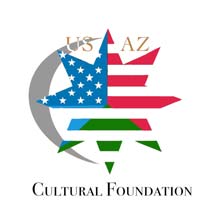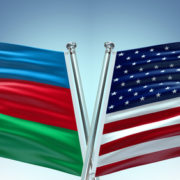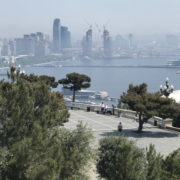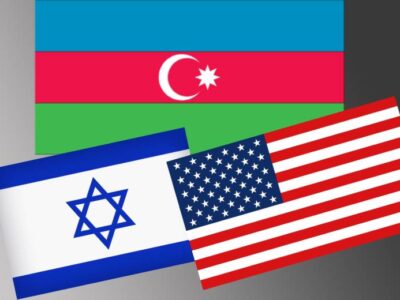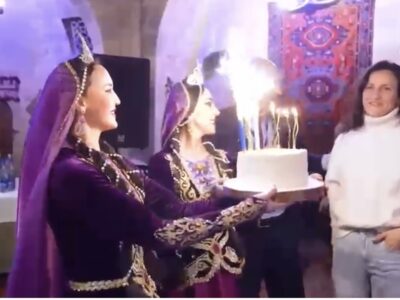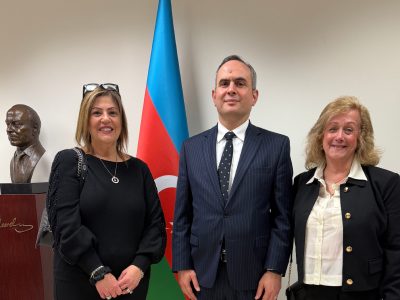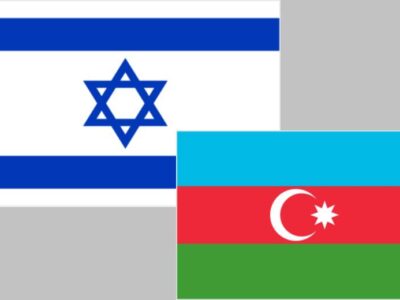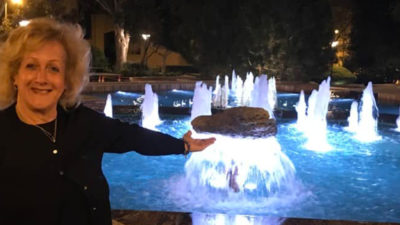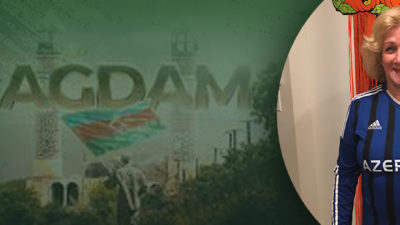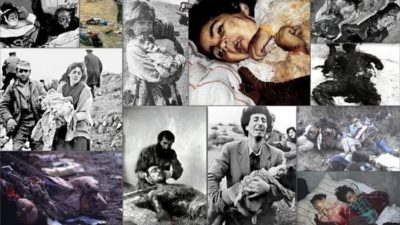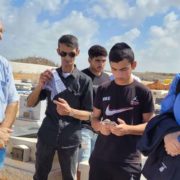The Nagorno-Karabakh enclave and 7 surrounding districts, in the Caucasus, suffered an appalling destruction by the Armenian occupiers, among the worst perpetrated at the end of the 20th and the beginning of the 21st centuries. The occupying Armenians carried out a demolition of both infrastructure and culture, but that made Azerbaijan more determined.
I am a Jew; I am a truth teller; I loathe injustice and more so, I despise destruction caused by irredeemable animosity.
There is an analogous case: Jerusalem, Israel, and Nagorno-Karabakh, Azerbaijan.
Jerusalem After 1948
Jerusalem’s fate after 1948 – Israel’s war for Independence – through 1967
Jerusalem has been and is the ancient capital of the three Jewish commonwealths, referring to a concept for the Jewish state: First Temple era, 1st Jewish Commonwealth; Second Temple era, 2nd Jewish Commonwealth; and the present modern state of Israel era, 3rd Jewish Commonwealth.
Soon after May 14, 1948, the date Israel declared its independence, the surrounding Arab states invaded the nascent Jewish state. The Arab Legion of Jordan attacked Jerusalem. Their forces blocked Jerusalem’s roads and cut off access to the city’s supplies and water. The city was under a siege for weeks on end. On May 27, 1948, after bitter fighting, the ancient Jewish Quarter of Jerusalem’s ancient city fell into the hands of the vastly superior arms and numbers of the Arab Legion.
The outcome of this war was, the ancient part of Jerusalem, where the Jewish Holy Temple once stood and where the Western Wall, the greatest sanctuary of the Jewish faith stands, remained illegally occupied by the Jordanians.
The Jordanians immediately expelled all the Jewish residents from Jerusalem; some of the expelled families lived in the city for centuries, through its thick and thin history. All but one of the 35 synagogues in the ancient city, King David town, were destroyed over the course of the next 19 years of Jordanian illegal occupation, either razed or used as stables and chicken coops. The Jordanians’ disrespect for other people’s religion and culture was incomprehensible.
The Republic of Azerbaijan
The Republic of Azerbaijan, with Baku its capital, is located at the boundary of Eastern Europe and Western Asia and is part of the South Caucasus region bounded by the Caspian Sea to the east, Russia to the north, Georgia to the northwest, Armenia and Turkey to the west, and Iran to the south.
On October 18, 1991, the Supreme Soviet of Azerbaijan adopted a Constitutional Act on the Declaration of Independence of Azerbaijan parting from the Soviet Union control. The declaration was confirmed by a referendum in December 1991.
Nagorno-Karabakh
The First Nagorno-Karabakh War, from February 1988 to May 1994, was an ethnic and territorial conflict that took place in the enclave of Nagorno-Karabakh in southwestern Azerbaijan, between the majority ethnic Armenians of Nagorno-Karabakh backed by Armenia and Russia, and the Republic of Azerbaijan, the rightful sovereign to the territory.
The outcome of the war was Nagorno-Karabakh enclave and seven surrounding districts, internationally recognized under Azerbaijan’s rightful sovereignty, were illegally occupied by Armenia until November 2020.
Some 800,000 ethnic Azerbaijanis were expelled from the territory, illegally occupied by Armenia, and their homes and places of worship were destroyed. Azerbaijan absorbed its people who became Internally Displaced People (IDP) in their own country.
Egregious Destruction by Armenia
While claiming the Nagorno-Karabakh as its own, naming it ‘Artsakh,’ or the ‘Republic of Artsakh,’ also known as the Nagorno-Karabakh Republic (NKR), while claiming it would like to arrive at a peace agreement with Azerbaijan and while deceiving the world of its intention for 30 years and holding the conflict frozen, Armenia was on a path of destruction in the illegally occupied territory. They had no peace in mind, rather hostility and destruction.
In his twitter feed the Consulate general of Azerbaijan in Los Angeles called this cultural demolition “Cultural Genocide in the Caucasus; the worst cultural genocide of the 21st century.”
November 8, 2020, was a turning point in Azerbaijan’s history. It was the day when the 30-year-long brutal injustice against the Azerbaijani people ended and justice was finally restored.

The Battle to Liberate Shusha
Shusha is a city in the Nagorno-Karabakh region of Azerbaijan, a mountain resort situated at an altitude of 1,400-1,800 meters (4,600-5,900 ft) in the Karabakh Mountains.
In 1992 Shusha was forcefully taken by Armenia. During and after the battle most of the city was destroyed and much of its Azerbaijani population was killed, expelled, or fled.
Between October 28 and October 30, 2020, Azerbaijani special operations forces deployed to isolate Shusha and disrupt the city’s defense. Some 400 Azerbaijani special forces carefully marched for five days through the forests and ravines, avoiding the Lachin corridor and the surrounding villages that were heavily guarded by Armenian forces. As the Azerbaijani soldiers approached the city they divided into 4 groups of 100 members each in order to approach the city from multiple directions and toward different objectives.
Many of the soldiers climbed, without fire support, the steep rocks and cliffs, left unguarded by the defending Armenians who seemed to have believed the Azerbaijani forces would attack mainly from main roads.
The cover of darkness, the ongoing Lachin Azerbaijan’s offensive, and failed imagination of the Armenian defenders enabled the Azerbaijani special operational forces to make their decisive move to covertly pierce the Shusha defense through ostensibly unpassable forests and mountainous terrain.
The Armenian forces who had control of the mountains surrounding Shusha ambushed the Azerbaijani forces who suffered heavy losses in the ravines leading up to the city and as they attempted to approach the city by road, they were exposed to recurrent artillery rockets and ambushes.
By late November 4, Azerbaijani forces had secured the south of Shusha mountain range and key portions of the Lachin corridor connecting Shusha to the town of Lachin.
By November 6, Azerbaijani troops reached the city’s outskirts.
When Argishti Kyaramyan, the Armenian military commander responsible for the defense of Shusha, left the city the Azerbaijani forces penetrated Shusha; they established further blocking positions and ambush sites around the city to prevent Armenians from being reinforced or resupplied. Other Azerbaijani troops captured Dashalti, a village just south of Shusha, providing immediate access to the main road into Shusha.
The foggy weather on November 7 significantly limited Azerbaijani forces’ use of aerial observation and strike assets that had given them such an advantage throughout the war. This enabled the Armenian forces to maximize the use of their armored vehicles, T-72 tanks, and BMP-2 infantry fighting vehicles – for counterattacks inside the city. However, the Azerbaijani forces bravely held their ground.
On November 9, 2020, Ilham Aliyev, Azerbaijani President declared Shusha a fully liberated city and on November 10, Nikol Pashinyan, Armenia’s Prime Minister signed an askew peace deal that included surrendering all areas of Nagorno-Karabakh that had been taken by Azerbaijan during the conflict – to include Shusha.
Shusha, the city where building and sustaining national identity and pride from a young age, the city that Azerbaijan considers to be its Cultural Capital and was illegally occupied for 30 years, was liberated.

Ağdam
Agdam, founded in the early 19th century, grew considerably during the Soviet period, and is the nominal capital of Agdam District of Azerbaijan.
In July 1993 during the First Nagorno-Karabakh War, as Azerbaijani forces withdrew from Karabakh, local Armenian forces captured Agdam.
Upon the seizure the Armenian forces destroyed the town while more damage occurred during the following decades when the abandoned town was looted for building purposes.
Ağdam is currently almost entirely ruined and uninhabited, prompting people to refer to it as the ‘Hiroshima of the Caucasus.’
Today Ağdam is a ghost town.
The Armenians did not live in Ağdam in the 30-year occupation period, nor did they allow Azerbaijanis to live there.
Eye witnesses who visited the city after the 2nd Nagorno-Karabakh War ended saw the malicious destruction and the abandonment of the multi-purpose Imarat Stadium, opened in 1952, and used as the FK Qarabağ home stadium and hosted the “Foreign Nightingale” mugam festival, a stadium where people lived their cultural lives, destroyed by the Armenian military forces’ bombardments during the First Nagorno-Karabakh conflict, in June 1993.
On November 20, 2020, as part of an agreement that ended the 2020 Nagorno-Karabakh war, the town and its surrounding district were returned to Azerbaijan’s control.
Fz Hasan on his Twitter feed writes: “Giyasli mosque, Agdam. it was a one beautiful mosque before #armenian occupation.”


The Fizuli Region
The Fizuli region, with caves and mounds, rich in historical, cultural and architectural monuments, bridges and numerous tombstones, was under Armenian occupation for 26 years.
Occupied historical monuments were destroyed by the Armenian occupiers: the 17th century caravanserai and mosque in Gargabazar village, the 18th century tomb, Ibrahim tomb in Ashagi Ayibasanli village, the 12th century cemetery and 13th century Mir Ali tomb in Ashagi Veysalli village, the 18th century mosque and residential building in Gochahmedli village, the 19th century mosque and Imamzadeh tomb in Horadiz, the 19th century mosques in Fuzuli city and Azykh Cave, one of the oldest human settlements in the world, as well as more than a dozen mound-type archeological monuments were the victims of cruel Armenian vandalism.

On Nov 10, Elin Suleymanov on his Twitter feed wrote: “On the way to @ShushaCity2021, along the Victory Road, we witnessed enormous level of utter hatred-driven destruction inflicted by three decades of occupation. Completely senseless and hard to believe unless witnessed firsthand.”
Back to Israel
Nearly twenty years after 1948, during the 1967 Six Day War, Israel’s army liberated the ancient city of Jerusalem. The liberators found the ancient Jewish Quarter completely neglected and much of it destroyed, the Western Wall abandoned and the Jewish cemetery on Mount of Olives desecrated, some of its tombstones were used elsewhere for construction work.
For a short while Israel cried for the destruction horror it faced, but almost immediately went to work to fix the harm done. Today, Jerusalem, the old and the new parts of the city, united as one, is a city to be jealous of; life is humming there.
Back to Azerbaijan
The 44-day-war of 2020 revealed to the Azerbaijani nation the destruction of some 20% of their country’s land caused by the Armenian occupiers. Furthermore, upon its victory Azerbaijan also faced the reality that an estimated $340 million worth of landmines were planted in Azerbaijan’s Karabakh region by the Armenians. So far these land mines are destroying lives while the Armenian government refuses to provide the available landmine maps, despite international calls for their release.
For a very short while the Azerbaijani Nation cried for the destruction horrors that were revealed to them and immediately thereafter went to work to fix the harm done. Azerbaijan, has engaged, at an unbelievable pace, in a massive reconstruction effort led by its president Ilham Aliyev with much support coming from the international community. In the very near future the Nagorno-Karabakh region and the surrounding 7 districts, that were orphans for nearly 30 years, will be smiling from the love of prosperity they are being shown and given by their motherland Azerbaijan.
Armenia must come to terms with the fact that hostility does not pay. A lasting peace between Armenia and Azerbaijan would be the perfect cure for the many years of fighting. Peace would allow the region to realize its full political and economic potential. Peaceful Armenia will bring the country to its neighbors’ orbit.
The time of infrastructure destruction and cultural demolition in this area has ended. Azerbaijan appears to be ready to move forward. It is up to Armenia to decide if it will move forward, or pass and miss the opportunity.
